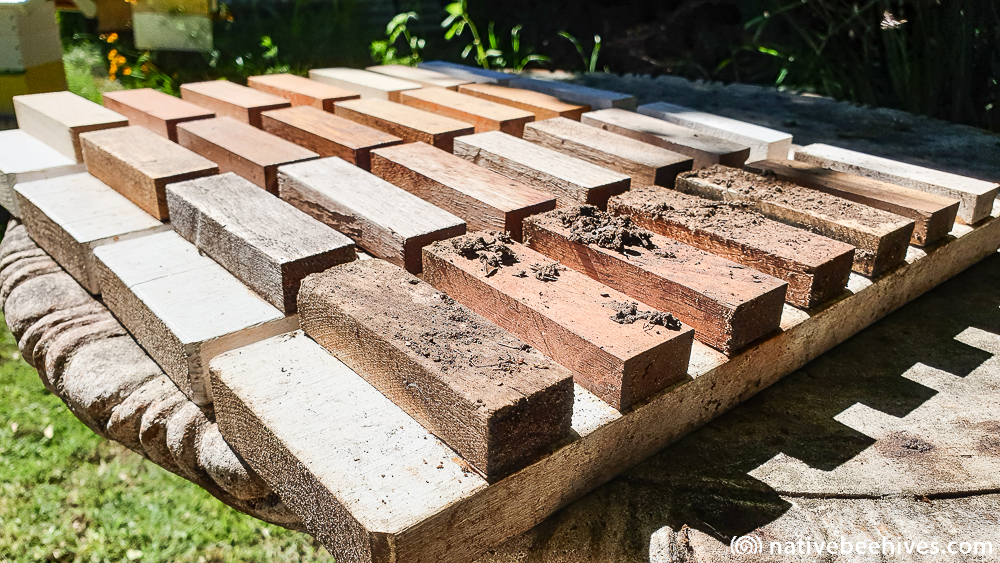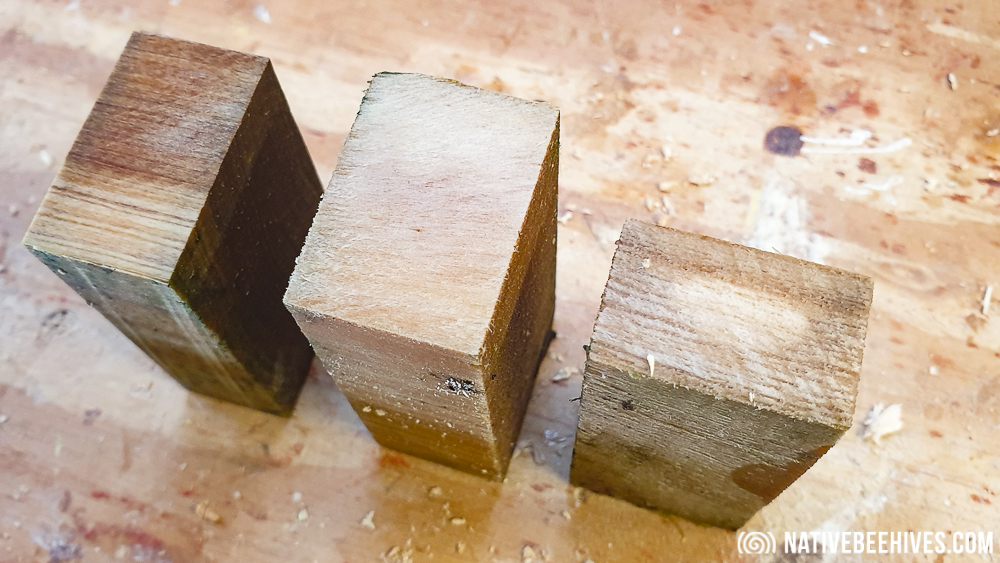
Start: October 2020
Wood Sample Test – Exposure to the elements
I thought i’d throw a few samples of different wood together for some weather exposure tests.

Alex of Spicers Hollow Native Bees is trialing some Paulownia and donated a few left over samples and also some PVC board that some box makers use, the rest of the wood is just what i had laying around.
I regularly use Cypress and Hoop Pine so i already know what happens to them over time when used for bee boxes and exposed to the elements. I am more interested to see how the Paulownia holds up when exposed to full weather over time for appearances and what happens to it when exposed to high moisture in the garden.
This might help with how we make native bee boxes, for example if we just use clear coat for a nice timber finish, but then in a few months the box looks terrible, we may just have to use paint.
I made four sample boards,
- Placed in the garden where it might have a high chance of rotting
- Placed beside a bee hive, full weather exposed to some sun and rain
- As above, this one has a clear coating
- Placed in the shed, used to compare with the others
Update: 26/12/2020 – 3 months from the start
Thoughts so far: A very noticeable difference with the Paulownia. It’s a very light wood, seems very porous, absorbs moisture, starting to mould. Chances are that it might go perfectly well as Native Bee boxes if it’s painted . The bees will coat the inside with propolis so the wood may be sealed off.
All other samples of wood seem unchanged. The Merbau has leached it’s stain everywhere.
Below photo: 1. From Left – In the garden for rot test / 2. Uncoated / 3. Clear Coated / 4. Stored in shed

Update below: April 2021 – 7 Months from the start
All looks fairly well unchanged from the last check
Below photo: 1. From Left – Stored in the shed / 2. Clear Coated / 3. Uncoated / 4. In the garden for rot test

Update below: November 2021 – 13 Months from the start
Below photo: 1. From Left – Stored in the shed / 2. Clear Coated / 3. Uncoated / 4. In the garden for rot test
All samples seem ok, normal sun fade etc. The Paulownia sample placed in the dirt/garden is noticeably soft compared to all the other woods. It’s a bit spongy like you could probably break pieces off. I try to make sure all pieces are evenly exposed to the dirt and moisture. *No bias.

Photo above: Paulownia closest to the camera on the sample board that is placed in the dirt / garden.
Update below: October 2022 – 2 years from the start
It’s been two years since the start of this wood sample test. Top board is the one kept in the shed, middle board is uncoated and left in full weather, rain and sun. The bottom board is up-side-down in contact with the dirt so is kept in a high moisture environment.
All samples on the middle board seem to be in pretty good condition for exposure to full weather for two years so the wood goes ok if it gets wet as long as it can dry out. The bottom board: Hoop pine and cedar looks to be nibbled on by termites? The Paulownia is soft like a sponge and would easily crumble apart.

Update below: September 2024 – 4 years from the start
Board 1. The top board is the original sample board that is kept protected in the shed.
Board 2. The samples have got a clear coat and are exposed to full weather, sun and rain. All wood samples are still hard and seem to be in good condition.
Board 3. The samples are uncoated and exposed to full weather, sun and rain all day. Most wood samples are hard and retain sharp edges. The Paulownia is noticeably soft and starting to decay. So if all surfaces of the Paulownia are sealed it might be ok, but say for example if your mating surfaces of your boxes are not sealed and exposed to moisture they could start to decay at a faster rate. Bees will chew through soft wood.
Board 4. This was placed in the dirt in the garden but I removed board 4 from the test about a year ago as it was starting to fall apart so it’s similar to the previous update. The Paulownia is very crumbly. The Hoop and Cedar look like they have been munched on by termites. If it wasn’t for the termites the samples might still be in reasonable condition.


The Pond Test – 11/01/2021

I saw a description for Paulownia that stated it doesn’t absorb water so I couldn’t resist. I placed Cypress, Hoop Pine and Paulownia in the pond.
Update: 15/04/2021: 3 months in the water
Photo below shows a cross cut section of the samples. The cypress and hoop pine completely water logged and the Paulownia on the right with a small dry area in the center. A pretty impressive result for the Paulownia.











